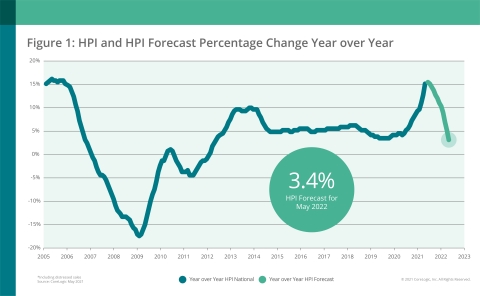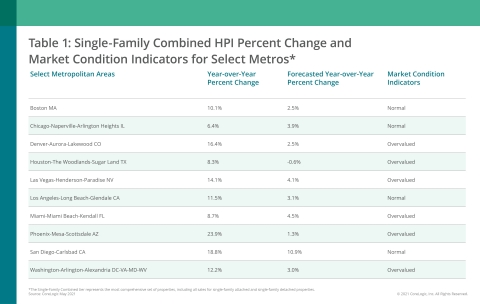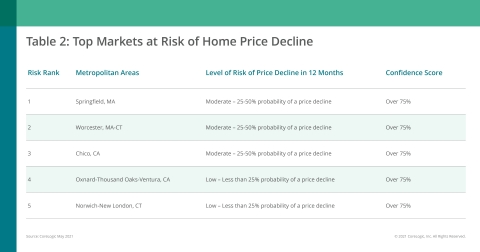CoreLogic, a leading global property information, analytics and data-enabled solutions provider, today released the CoreLogic Home Price Index (HPI™) and HPI Forecast™ for May 2021.
Converging pressures of severe inventory shortages and sustained demand pushed home prices to record highs in May, with the year-over-year increase in home prices at its highest level since 2005. While many millennials and Gen Z home buyers continue to move into the hot market thanks to low borrowing rates, high prices are likely deterring increasing numbers of prospective buyers — especially first-time and low-income families. Currently, 82% of consumers note housing affordability as a key problem, according to a recent CoreLogic survey. Additionally, 33% of respondents noted they would wait to buy or not buy at all rather than make sacrifices on their purchase.
“First-time buyers are hitting a wall in many places around the country as the pace of home price rises outpace the benefits of lower borrowing costs. Younger and first-time buyers, including younger millennials, are faced with the challenge of having sufficient savings for a down payment, closing costs and cash reserves,” said Frank Martell, president and CEO of CoreLogic. “As we look to the balance of 2021, we expect price rises to continue which could very well push prospective buyers out of the market in many areas and slow home price growth over the next year.”
Top Takeaways:
- Nationally, home prices increased 15.4% in May 2021, compared with May 2020. On a month-over-month basis, home prices increased by 2.3% compared to April 2021.
- Appreciation of detached properties (17.2%) was nearly double that of attached properties (9.1%) in May as prospective buyers continue to seek out more space.
- Home prices are projected to increase 3.4% by May 2022, as affordability challenges deter potential buyers and cause a slowdown in home price growth.
- In May, home prices rose sharply in the west with Twin Falls, Idaho, experiencing the highest year-over-year increase at 35%. Coeur d’Alene, Idaho, ranked second with a year-over-year increase of 32%.
- At the state level, Idaho and Arizona continued to have the strongest price growth at 30.3% and 23.4%, respectively. Utah also had a 20.4% year-over-year increase as home buyers seek out more affordable locations with lower population density and attractive outdoor amenities.
“There are marked differences in today’s run up in prices compared to 2005, which was a bubble fueled by risky loans and lenient underwriting,” said Dr. Frank Nothaft, chief economist at CoreLogic. “Today, loans with high-risk features are absent and mortgage underwriting is prudent. However, demand and supply imbalances — fueled by a drop in mortgage rates to less than one-half what they were in 2005 and a scarcity of for-sale homes — has fed the latest run up in sales prices.”
The next CoreLogic HPI press release, featuring June 2021 data, will be issued on August 3, 2021, at 8:00 a.m. ET.
Methodology
The CoreLogic HPI™ is built on industry-leading public record, servicing and securities real-estate databases and incorporates more than 45 years of repeat-sales transactions for analyzing home price trends. Generally released on the first Tuesday of each month with an average five-week lag, the CoreLogic HPI is designed to provide an early indication of home price trends by market segment and for the “Single-Family Combined” tier, representing the most comprehensive set of properties, including all sales for single-family attached and single-family detached properties. The indices are fully revised with each release and employ techniques to signal turning points sooner. The CoreLogic HPI provides measures for multiple market segments, referred to as tiers, based on property type, price, time between sales, loan type (conforming vs. non-conforming) and distressed sales. Broad national coverage is available from the national level down to ZIP Code, including non-disclosure states.
CoreLogic HPI Forecasts™ are based on a two-stage, error-correction econometric model that combines the equilibrium home price—as a function of real disposable income per capita—with short-run fluctuations caused by market momentum, mean-reversion, and exogenous economic shocks like changes in the unemployment rate. With a 30-year forecast horizon, CoreLogic HPI Forecasts project CoreLogic HPI levels for two tiers — “Single-Family Combined” (both attached and detached) and “Single-Family Combined Excluding Distressed Sales.” As a companion to the CoreLogic HPI Forecasts, Stress-Testing Scenarios align with Comprehensive Capital Analysis and Review (CCAR) national scenarios to project five years of home prices under baseline, adverse and severely adverse scenarios at state, metropolitan areas and ZIP Code levels. The forecast accuracy represents a 95% statistical confidence interval with a +/- 2% margin of error for the index.
About Market Risk Indicator
Market Risk Indicators are a subscription-based analytics solution that provide monthly updates on the overall “health” of housing markets across the country. CoreLogic data scientists combine world-class analytics with detailed economic and housing data to help determine the likelihood of a housing bubble burst in 392 major metros and all 50 states. Market Risk Indicators is a multi-phase regression model that provides a probability score (from 1 to 100) on the likelihood of two scenarios per metro: a >10% price reduction and a ≤ 10% price reduction. The higher the score, the higher the risk of a price reduction.
About the Market Condition Indicators
As part of the CoreLogic HPI and HPI Forecasts offerings, Market Condition Indicators are available for all metropolitan areas and identify individual markets as “overvalued”, “at value”, or “undervalued.” These indicators are derived from the long-term fundamental values, which are a function of real disposable income per capita. Markets are labeled as overvalued if the current home price indexes exceed their long-term values by greater than 10%, and undervalued where the long-term values exceed the index levels by greater than 10%.























